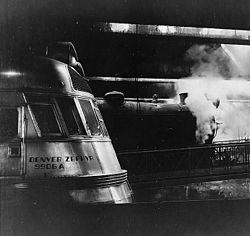- Twin Cities Zephyr
-
Twin Cities Zephyr
Morning Zephyr
Afternoon Zephyr
Denver Zephyr locomotive 9906A sitting next to a steam engine at Chicago Union Station in 1943. The early Twin Cities Zephyrs used the same design.Overview Service type Daytime inter-city rail Status Discontinued Locale Minnesota, Wisconsin, Illinois First service April 21, 1935[1] Last service April 30, 1971 Former operator(s) Chicago, Burlington and Quincy Railroad (1935–70)
Burlington Northern (1970–71)Route Start Chicago, Illinois End Minneapolis, Minnesota Train number(s) 21, 22, 23, 24 On-board services Class(es) Coach and Parlor Observation facilities 1947: Four dome coaches, one dome parlor Technical Rolling stock 1935: Two articulated 3-sets,
1936: Two articulated 6-sets,
1947: Two sets of 7 non-articulated carsGauge 4 ft 8 1⁄2 in (1,435 mm) The Twin Cities Zephyr was a streamlined passenger train service of the Chicago, Burlington and Quincy Railroad (CB&Q). It was the second Zephyr service introduced by CB&Q following the record-setting Denver–Chicago "dawn to dusk dash" of the Pioneer Zephyr trainset. Since the service was inaugurated with an identical pair of diesel powered trains that ran in opposite directions, it was sometimes called the Twin Zephyrs. The service was discontinued in 1971 with the inauguration of Amtrak.
The train primarily competed with the Chicago and North Western's Twin Cities 400 which ceased operation in 1963, and the Milwaukee Road's Twin Cities Hiawatha which continued as an Amtrak service until 1978.
History
The first 2 trainsets (numbered 9901, 9902) of 3 cars each were delivered in April 1935, but quickly proved to lack sufficient passenger capacity to meet demand. A second pair of 6 car trains with matching locomotives were ordered as replacements.
The second pair of Twin Cities Zephyrs entered service on December 18, 1936, so the CB&Q operated the two pairs as the Morning Zephyr and the Afternoon Zephyr. For the first run, the two trainsets built for the service departed Chicago simultaneously on parallel tracks with several pairs of twins as a publicity stunt.[citation needed]
The Twin Cities Zephyr served the Midwest in 36 years, a long lifetime for the 1930s high-speed trains. Their last service occurred in 1971 when Amtrak took over the majority of intercity passenger train service in the United States.[2]
According to railroad house organ magazines, The Twin Cities Zephyrs for many years ran the highest average speeds in the United States between Chicago and Minneapolis-St. Paul, eased by the gradual grades along the Mississippi River. The trains ran a six-hour schedule over 427 miles (687 km), for an overall average of 71 miles per hour (114 km/h)—as fast as today's Acela Express. It is believed that for several years a stretch in the middle of the route centered at Prairie du Chien, Wisconsin had the highest scheduled speeds in the world, requiring an average of 84.4 mph (135.8 km/h) from Prairie du Chien north to La Crosse,[1] and the stretch from Prairie du Chien south to East Dubuque, Illinois required an average of 84 mph (135 km/h).[3]
Equipment used
The first pair of 3-car Twin Zephyr trainsets (very similar to the original Pioneer Zephyr) delivered in April 1935 quickly proved too small to cope with passenger loads, and a second pair of 6 car trains (soon expanded to 7 cars) were delivered in November 1936. Motive power for the second pair of trains was originally shovelnose diesel locomotives 9904 Pegasus, & 9905 Zephyrus. After a 3rd pair of trains were delivered, the second pair of trains was reassigned as the Nebraska Zephyrs. The 3rd set of typically 7 cars, delivered in 1947, was the first dome streamliner train, after a company built modified coach dome car was tested starting in 1945. The 1947 set originally consisted of a baggage-refreshment car, 4 vista dome coaches, a dining car and a dome parlor observation car. It served as a prototype of the 1949 California Zephyr which also had sleeping cars.
References
- Zimmerman, Karl (2004). Burlington Zephyrs. Andover Junction Publications. ISBN 0-7603-1856-5.
- ^ a b Jim Scribbins (2007). The Hiawatha Story. Minneapolis/London: University of Minnesota Press (originally published by Kalmbach Publishing Co., 1970). ISBN 978-0-8166-5003-3.
- ^ "The Decline of the Streamliner", http://web.me.com/willvdv/chirailfan/strdecl.html; visited November, 2010.
- ^ John Kelly (2002). Streamliners to the Twin Cities Photo Archive. Hudson, Wisconsin: Iconografix. ISBN 1-58388-096-8.
North American Lightweight passenger trains by manufacturer ACF ACF-Talgo • B&M Speed Merchant • MotorailerANF / Rohr Bombardier / MLW Budd GM / EMD Goodyear / Zeppelin Pullman IC Green Diamond • NYC Xplorer • NYNH&H Dan'l Webster • UP M-10000 • UP M-10001 • UP M-10002 • UP M-10003 – M-10006United Aircraft / Pullman / MLW See also: Lightweight Train LocomotivesCategories:- Passenger trains of the Chicago, Burlington and Quincy Railroad
- Named passenger trains of the United States
- 1936 introductions
- Chicago, Burlington and Quincy Railroad
- Articulated passenger trains
- Night trains of the United States
Wikimedia Foundation. 2010.


